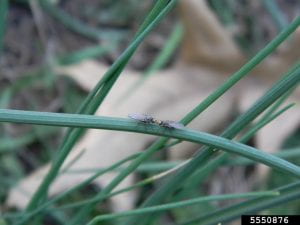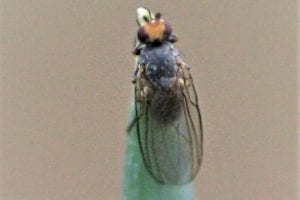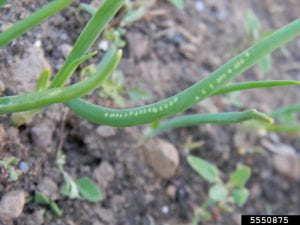Allium leafminer (ALM), Phytomyza gymnostoma (Diptera: Agromyzidae), is an invasive leaf-mining fly from Poland that was first detected in Pennsylvania in 2015. They overwinter as pupae in plant tissue or surrounding soil. Adults emerge mid-March throughout April (250°Degree Days with a minimum temperature threshold of 3.5°C.). The adults are small (~ 3 mm) long grey or black flies with a distinctive yellow or orange area on the top and front of head and legs have distinctive yellow “knees” (Fig.1, Fig 2). The larvae are white maggots, headless, and around ~ 8 mm long at their final instar. The pupa are dark brown, ~3.5 mm long.


Adults will mate lay eggs inside the leaves of Allium species, creating a row of several small round white dots (made by the female’s ovipositor) on the top half of the leaf blades (Fig.3). Larvae mine leaves and move towards and into bulbs and leaf sheathes. Damage from Allium leafminer can also cause the plant to exhibit curly, wavy or distorted leaves. Both the leaf punctures and mines serve as entry routes for bacterial and fungal pathogens. The larvae may move into the soil to pupate. These pupae undergo a diapause period which lasts throughout the summer, and will emerge as adults in the autumn (September / October).

While spring crops are usually not as hard hit as fall crops, this pest has been steadily increasing its geographical range each year and its damage potential. Fields that had pressure last year should be scouted for feeding damage this year. Yellow sticky cards or yellow plastic bowls containing soapy water can be used for monitoring this pest. You can reduce infestation rates by rotating fields, growing leeks as far as possible from chives, and delaying the planting of spring allium crops. Growing allium crops on reflective mulch has reduced the severity of allium leafminer damage in research trials in New York. Placing row covers over allium crops during the period flies and keeping plants covered during the 3-4 weeks of emergence will exclude the pest. Larvae and pupa tend to be found in the outermost layers of leaves from leek and scallion, so the hand removal of these layer will often create a blemish-free product.
Several systemic and contact insecticides are approved for this pest, but EPA registrations vary among Allium crops. When using chemical control, check labels to ensure the crop is listed and for rates and days-to-harvest intervals. Always read and follow the label. The label is the Law.
For chemical recommendations, see the 2020-2021 Mid-Atlantic Commercial Vegetable Production Recommendation Guide: https://extension.umd.edu/mdvegetables/2020-2021-mid-atlantic-commercial-vegetable-production/commodity-recommendations
Azadirachtin (Aza-Direct or other formulations) or spinosad (Entrust or other formulations) are options for organic chemical control.
